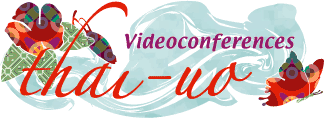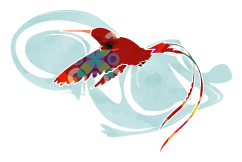Part 2: Resource-Rich Class, Session 6
 |
||
 |
Documents |
|
Handouts and Resources Lecture Guide for Session 6 Slides for Session 6 |
Videos |
|
Online access to the videoconference lecture requires a broadband (DSL, cable, ethernet, etc.) Internet connection. The lecture is freely available below in Windows Media Player, RealPlayer and QuickTime formats for both Windows and Macintosh computers. Session 6, Windows Media Session 6, RealPlayer Session 6, QuickTime |
Creating a Resource-Rich Classroom
Session 6 – June 6, 2006
Introduction
Leslie Opp-Beckman, University of Oregon
Linguistics Department, American English Institute
Email: leslieob@uoregon.edu or use the Contact web page.
About the Speaker
Leslie Opp-Beckman is a Senior Instructor in the MA Language Teaching Specialization program for the Linguistics Department at the University of Oregon. She also develops online training, teaches courses, and acts as Technology Coordinator for the American English Institute.
Overview
This is the introductory session for Part II of the 2005-06 professional development series for English as a Foreign Language (EFL) educators in Thailand. It is the first of five sessions on “Creating a Resource-Rich Classroom.” University of Oregon is partnering with the US Embassy in Bangkok, the Royal Thai Distance Learning Foundation, the Ministry of Education, colleagues at Chulalongkorn University, and at ThaiTESOL on this innovative and exciting project.
Online Teacher Resources
To develop language competence, students benefit from being exposed to as many resources as possible in the target language. The focus for Part II is on creating a “resource-rich” classroom that supports the development of literacy skills in English. Following are some key resources in support of the Part II sessions.
- Literacy-Rich Classrooms
This diagram shows the nine characteristics of a resource / literacy-rich classroom. - Resource and Literacy-Rich Environments
The following excerpt is adapted from The Access Center: Literacy-Rich Environments. The intentional selection and use of materials is central to the development of the literacy rich environment. Teachers ensure that students have access to a variety of resources by providing many choices. Teachers can alternate readings in the class to maintain student’s interest and expose them to various genres and ideas. For example, teachers should include both fiction and nonfiction literature. Classrooms should also include miscellaneous literacy materials that are used in everyday life to further demonstrate how literacy is used.Materials examples include: Maps, dictionaries, menus, recipes, labels, phone books, signs, printed directions, and student work.Activity (student work) examples with the theme “World Exploration” could include:
— Identifying cities and places from newspapers and marking them on a map for “world explorations” (e.g. printable maps).
— Reading fiction and nonfiction stories and articles about these places (e.g. folktales and mysteries; news and catalogs).
— Creative writing activities related to the places under exploration (e.g. Headline Poems).
— Making timelines (graphs) for current events or historical events that occurred in these places (e.g. Timelines).
— Creating thematic collages with images that represent the location (e.g. Collages).
— Listening to and singing songs that are related to people, things, or features about these places (e.g. Mama Lisa’s World).
— Graphing the daily temperature on a wall or bulletin board (e.g. Weather Watchers).
— “Imagine I am…” first person diary journals that describe typical activities that a person from this part of the world would do on that day and under those weather conditions (e.g. Ancient Greece, Egypt and Rome). - Introduction: Adolescent Literacy in Perspective
The following excerpt is adapted from this book chapter. It explains some principles to guide us in our thinking on literacy for teens. In 1999 the International Reading Association published a list of seven areas of support for all adolescent literacy learners:
— Access to a wide variety of reading material that appeals to their interests.
— Instruction that builds the skill and desire to read increasingly complex materials.
— Assessment that shows their strengths as well as their needs.
— Expert teachers who model and provide explicit instruction across the curriculum.
— Reading specialists who assist students having difficulty learning how to read.
— Teachers who understand the complexities of individual adolescent readers.
— Homes and communities that support the needs of adolescent learners.
In 2004 the National Council of Teachers of English created an additional list of guidelines for supporting adolescent learners, summarized here. Adolescent readers need:
— Experiences with diverse texts and multiple perspectives.
— Authentic, student-initiated discussions about text.
— Experiences to reflect critically on their own literacy processes.
— Experiences examining texts critically.
Teachers of adolescents need:
— Adequate reading materials that span difficulty levels and relate to students’ interests.
— Professional development that helps them to link students’ personal literacy with school literacy…to identify students’ dilemmas in reading and respond with appropriate support, to support student-led discussions about text, and to create contexts in which students can critically examine texts.
Review: Discussion Questions and Classroom Applications
- Make a list (inventory) of all materials in English that you currently have in your class(es). These may be items such as books, dictionaries, posters, audio tapes…what else?
- Brainstorm with others in your group, and make a second list of materials in English that you can find in your community. Also note the places where you can find them (hotels, restaurants, tourist information centers, businesses, etc.). These may be items such as newspapers, magazines, brochures, menus, old phone books…what else?
- Gather up as many as you can find and bring samples to the next session.Bring multiple sets of materials if you would like to participate in a materials “swap” or exchange.
- Also bring your class text or syllabus to the next session. Choose 1-3 possible themes from your curriculum or text that you can use to create a “resource-rich” class module as project for these five sessions.